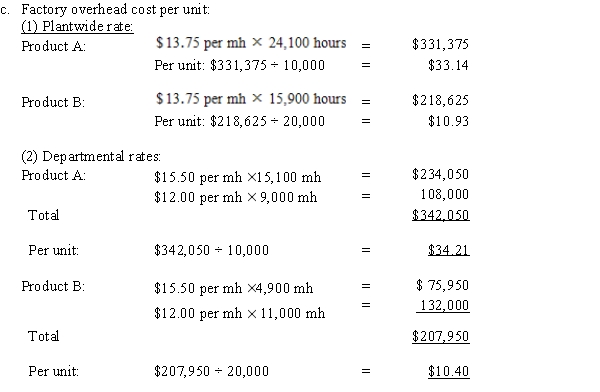Asked by Harpreet Kaur Dhillon on Jul 16, 2024

Verified
Condoleezza Co. manufactures two products, A and B, in two production departments, Assembly and Finishing. Condoleezza Co. expects to produce 10,000 units of Product A and 20,000 units of Product B in the coming year. Budgeted factory overhead costs for the coming year are:  The machine hours expected to be used in the coming year are as follows:
The machine hours expected to be used in the coming year are as follows: 
a.Compute the plantwide factory overhead rate, assuming the single plantwide factory overhead rate method is used.
b.Compute the production department factory overhead rates, assuming the multiple production department factory overhead rate method is used.
c.Compute the factory overhead allocated per unit for each product using (1) the single plantwide rate and (2) production department factory overhead rates.
d.Which method is better (single or multiple)? Why?
Plantwide Factory Overhead Rate
A single overhead absorption rate used throughout a factory, applied to all production units irrespective of departmental differences.
Production Department
A production department is a specialized unit within a manufacturing firm that is responsible for the process of converting raw materials into finished goods.
Allocated Per Unit
The process of assigning a portion of total costs directly to individual units of production or service.
- Gain an understanding of how to calculate and apply a single plantwide overhead rate for factories, using direct labor hours as the basis.
- Assess the benefits of employing various production department overhead rates compared to a single plantwide overhead rate.
- Calculate and compare factory overhead allocated per unit under different costing methods.

Verified Answer

 d.The multiple production department factory overhead rate method is better. This method is more accurate. Using the single plantwide factory overhead rate method undercosts each unit of A and overcosts each unit of B.
d.The multiple production department factory overhead rate method is better. This method is more accurate. Using the single plantwide factory overhead rate method undercosts each unit of A and overcosts each unit of B.
Learning Objectives
- Gain an understanding of how to calculate and apply a single plantwide overhead rate for factories, using direct labor hours as the basis.
- Assess the benefits of employing various production department overhead rates compared to a single plantwide overhead rate.
- Calculate and compare factory overhead allocated per unit under different costing methods.
Related questions
Anazi Leather Company Manufactures Leather Handbags and Moccasins ...
Tulip Company Produces Two Products, T and U ...
In an Effort to Simplify the Multiple Production Department Factory ...
Sawtooth Leather Company Manufactures Leather Handbags and Moccasins ...
If a Desk Lamp Requires 1 Hour of Fabrication and ...